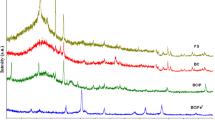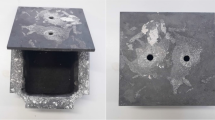Abstract
Switchgrass biochar (SGB) was made by fast pyrolysis in an auger-fed reactor at 425 °C with a solid residence time of 60 s in the pyrolysis zone during bio-oil production. Magnetic switchgrass biochar (MSGB) was prepared by iron oxide precipitation onto the biochar surface using an aqueous Fe3+/Fe2+ solution followed by NaOH treatment. Both the SGB and the MSGB were characterized by FTIR, SEM, SEM-EDX, TGA, pHpzc, elemental analysis, and surface area measurements. Batch sorption studies of metribuzin from aqueous solutions were carried out at different pH values, adsorbate concentrations, and temperatures. The adsorption of metribuzin onto both biochars was highest at a pH of 2. Adsorption isotherms were evaluated from 25 to 45 °C using the Freundlich, Langmuir, Redlich-Peterson, Toth, Sips, Koble-Corrigan, and Radke-Prausnitz adsorption models. Langmuir adsorption capacities at pH 2 were Q 0 SGB ~ 151, 223, and 205 mg/g and Q 0 MSGB ~ 155, 205, and 155 mg/g at 25, 35, and 45 °C, respectively. Low-cost magnetization of the biochar occurred without significant loss of absorption capacity, enabling facile separation of slurried biochar from liquids following contaminate absorption.

ᅟ







Similar content being viewed by others
References
Aggarwal V, Li H, Teppen BJ (2006) Triazine adsorption by saponite and beidellite clay minerals. Environ Toxicol Chem 25(2):392–399
Antonopoulou M, Konstantinou I (2014) Photocatalytic treatment of metribuzin herbicide over TiO2 aqueous suspensions: removal efficiency, identification of transformation products, reaction pathways and ecotoxicity evaluation. J Photoch Photobio A 294:110–120. doi:10.1016/j.jphotochem.2014.08.008
Baig SA, Zhu J, Muhammad N, Sheng T, Xu X (2014) Effect of synthesis methods on magnetic Kans grass biochar for enhanced As (III, V) adsorption from aqueous solutions. Biomass Bioenerg 71:299–310
Boateng AA, Mullen CA, Goldberg NM, Hicks KB et al (2010) Sustainable production of bioenergy and biochar from the straw of high-biomass soybean lines via fast pyrolysis. Environ Prog Sustain Energy 29(2):175–183. doi:10.1002/ep.10446
Brewer CE, Schmidt-Rohr K, Satrio JA, Brown RC (2009) Characterization of biochar from fast pyrolysis and gasification systems. Environ Prog Sustain Energy 28(3):386–396
Cerejeira M, Viana P, Batista S, Pereira T et al (2003) Pesticides in Portuguese surface and ground waters. Water Res 37(5):1055–1063
Essandoh M, Kunwar B, Pittman CU Jr, Mohan D, Mlsna T (2015) Sorptive removal of salicylic acid and ibuprofen from aqueous solutions using pine wood fast pyrolysis biochar. Chem Eng J 265:219–227. doi:10.1016/j.cej.2014.12.006
Fairchild JF, Sappington LC (2002) Fate and effects of the triazinone herbicide metribuzin in experimental pond mesocosms. Arch Environ Contam Toxicol 43:198–202
Gupta VK, Nayak A, Agarwal S, Tyagi I (2014) Potential of activated carbon from waste rubber tire for the adsorption of phenolics: effect of pre-treatment conditions. J Colloid Interface Sci 417:420–430
Henriksen T, Svensmark B, Juhler RK (2002) Analysis of metribuzin and transformation products in soil by pressurized liquid extraction and liquid chromatographic-tandem mass spectrometry. J Chromatogr A 957(1):79–87
Huertas-Pérez JF, del Olmo IM, García-Campaña AM, González-Casado A, Sánchez-Navarro A (2006) Determination of the herbicide metribuzin and its major conversion products in soil by micellar electrokinetic chromatography. J Chromatogr A 1102(1–2):280–286. doi:10.1016/j.chroma.2005.10.052
Janke D (1989) Herbicides—chemistry, degradation, and mode of action. Marcel Dekker Inc, New York
Kim P, Johnson A, Edmunds CW, Radosevich M, Vogt F, Rials TG, Labbé N (2011) Surface functionality and carbon structures in lignocellulosic-derived biochars produced by fast pyrolysis. Energy Fuel 25(10):4693–4703
Komulainen H (2004) Experimental cancer studies of chlorinated by-products. Toxicol 198(1–3):239–248. doi:10.1016/j.tox.2004.01.031
Kumar YB, Singh N, Singh SB (2013) Removal of atrazine, metribuzin, metolachlor and alachlor by granular carbon. J Environ Anal Toxicol 3(7):1–5
Lagergren S, Svenska BK, Swed R (1898) Acad Sci Doc Band 24:1–13
Laird DA (2008) The charcoal vision: a win-win-win scenario for simultaneously producing bioenergy, permanently sequestering carbon, while improving soil and water quality. Agron J 100(1):178–181. doi:10.2134/agrojnl2007.0161
Langmuir I (1918) The adsorption of gases on plane surfaces of glass, mica and platinum. J Am Chem Soc 40(9):1361–1403. doi:10.1021/ja02242a004
Lawrence JR, Eldan M, Sonzogni WC (1993) Metribuzin and metabolites in Wisconsin (U.S.A.) well water. Water Res 27(8):1263–1268. doi:10.1016/0043-1354(93)90212-Z
Liu Y, Zhu X, Qian F, Zhang S, Chen J (2014) Magnetic activated carbon prepared from rice straw-derived hydrochar for triclosan removal. RSC Adv 4(109):63620–63626. doi:10.1039/C4RA11815D
McHenry MP (2009) Agricultural bio-char production, renewable energy generation and farm carbon sequestration in Western Australia: certainty, uncertainty and risk. Agric Ecosyst Environ 129(1–3):1–7. doi:10.1016/j.agee.2008.08.006
Mohan D, Rajput S, Singh VK, Steele PH, Pittman CU Jr (2011a) Modeling and evaluation of chromium remediation from water using low cost bio-char, a green adsorbent. J Hazard Mater 188(1–3):319–333. doi:10.1016/j.jhazmat.2011.01.127
Mohan D, Sarwat A, Singh VK, Alenxandre-Franco M, Pittman CU Jr (2011b) Development of magnetic activated carbon from almond shells for trinitrophenol removal from water. Chem Eng J 172(2–3):1111–1125. doi:10.1016/j.cej.2011.06.054
Novak JM, Lima I, Xing B, Gaskin JW et al (2009) Characterization of designer biochar produced at different temperatures and their effects on a loamy sand. Ann Environ Sci 3(1):195–206
Oliveira LCA, Rios RVRA, Fabris JD, Garg V, Sapag K, Lago RM (2002) Activated carbon/iron oxide magnetic composites for the adsorption of contaminants in water. Carbon 40(12):2177–2183. doi:10.1016/S0008-6223(02)00076-3
Olsen P, Henriksen T, Ullum M (2005) Leaching of metribuzin metabolites and the associated contamination of a sandy Danish aquifer. Environ Sci Technol 39(21):8374–8381. doi:10.1021/es0506758
Osteen CD, Fernandez-Cornejo J (2013) Economic and policy issues of U.S. agricultural pesticide use trends. Pest Manag Sci 69(9):1001–1025. doi:10.1002/ps.3529
Pittman CU Jr, Mohan D, Eseyin A, Li Q et al (2012) Characterization of bio-oils produced from fast pyrolysis of corn stalks in an auger reactor. Energy Fuel 26(6):3816–3825. doi:10.1021/ef3003922
Pot V, Benoit P, Menn ML, Eklo O-M, Sveistrup T, Kværner J (2011) Metribuzin transport in undisturbed soil cores under controlled water potential conditions: experiments and modelling to evaluate the risk of leaching in a sandy loam soil profile. Pest Manag Sci 67(4):397–407. doi:10.1002/ps.2077
Sha’ato R, Buncel E, Gamble D, VanLoon G (2000) Kinetics and equilibria of metribuzin sorption on model soil components. Can J Soil Sci 80(2):301–307
Singh N (2009) Adsorption of herbicides on coal fly ash from aqueous solutions. J Hazard Mater 168(1):233–237. doi:10.1016/j.jhazmat.2009.02.016
Thelin GP, Stone WW (2013). Estimation of annual agricultural pesticide use for counties of the conterminous United States, 1992–2009: US Department of the Interior, US Geological Survey
Tiryaki O, Temur C (2010) The fate of pesticide in the environment. J Biol Environ Sci 4(10):29–38
Tombacz E, Majzik A, Horvat Z, Illes E (2006) Magnetite in aqueous medium: coating its surface and surface coated with it. Rom Rep Phys 58(3):281–286
USEPA (1987). Metribuzin: health advisory. Washington, DC
USEPA (2003). Health effect support document for metribuzin
Weber TW, Chakravorti RK (1974) Pore and solid diffusion models for fixed-bed adsorbers. AICHE J 20(2):228–238. doi:10.1002/aic.690200204
Yavuz CT, Mayo J, William WY, Prakash A et al (2006) Low-field magnetic separation of monodisperse Fe3O4 nanocrystals. Science 314(5801):964–967
Zhang M, Gao B (2013) Removal of arsenic, methylene blue, and phosphate by biochar/AlOOH nanocomposite. Chem Eng J 226:286–292
Acknowledgements
Authors would like to acknowledge support from the University Grants Commission for the Joint Research Program entitled “Indo-US initiatives on Cleaner Energy and Water Research” between Jawaharlal Nehru University and Mississippi State University and the Mississippi State University Chemistry Department for financial support of this project. The authors would also like to acknowledge Dr. El Barbary Hassan of Mississippi State University for assistance in biochar analysis.
Author information
Authors and Affiliations
Corresponding author
Ethics declarations
Conflict of interest
The authors declare no competing financial interest.
Additional information
Responsible editor: Hailong Wang
Electronic supplementary material
ESM 1
(DOCX 1929 kb)
Rights and permissions
About this article
Cite this article
Essandoh, M., Wolgemuth, D., Pittman, C.U. et al. Adsorption of metribuzin from aqueous solution using magnetic and nonmagnetic sustainable low-cost biochar adsorbents. Environ Sci Pollut Res 24, 4577–4590 (2017). https://doi.org/10.1007/s11356-016-8188-6
Received:
Accepted:
Published:
Issue Date:
DOI: https://doi.org/10.1007/s11356-016-8188-6




